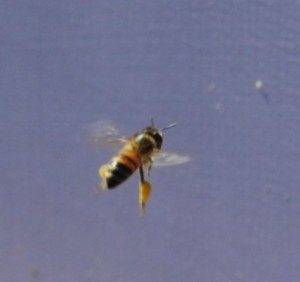Another Trap Out Nuc
This year, I started a trap out in a nice neighborhood in Richmond called Windsor Farms. A couple were moving into a house last Fall and discovered a bee hive in a huge tree in their backyard. Although an avid gardener, I am not an expert on trees, so I do not know the name of it, but it has very deep, ridged bark. This is a very important point for trap outs, as I was to come to find out.
At any rate, I advised the home owner that a trap out last Fall wouldn’t work (might as well kill the bees.) It had been a horrible Summer with very little rain and I had my doubts that a hive could build up enough stores if you trapped them out at this time. He was very cool about it and said we could knock it out the following Spring (2011).
Trapouts basically utilize a rolled-up cone with wire that is about a quarter inch square. The whole idea is that the bees crawl from the tree (the wide end of the cone) to the exit (a narrow end, about the size of two drones) and leave the hive. When they return, they go back to the base (but on the outside) and cannot figure out how to get back into the hive (smell drives them to the base of the cone.) It’s like a crap trap, but in reverse.
The beekeeper then sets up a hive with the entrance right near the cone and the bees, after failing to get into the hive all day, go into the hive (or trap out.) Most beekeepers put a frame of capped brood into the hive with the bees to entice the ‘trapped out’ bees to stay in the trap hive body.
Last year, a fellow in Buckingham introduced me to a slightly modified version of this trick. Instead of running a cone out of the hive, you run a piece of PVC out of the hive (tapped up all around it so that this is the only way the bees can leave) into the bottom of the trapout Deep. The bees have to climb through your foundation/comb to get out and cannot get back in.
I took an old Medium and drilled a hole for the PVC into it. I then placed my ‘cone’ so that bees leaving the PVC pipe would have to go through the cone and would not be able to return in this fashion, being trapped in my hive. The real benefit of this method (or so it is said) is that the queen will eventually leave through the pipe and remain in your hive (you get bees as well as the great genetics of a wild hive.)
Well, I set this up in late March and started to watch. This is where the ‘ridged’ tree comment comes in from before. It was extremely difficult to block up the ridges and the bees continued to get back into the tree hive (a bad thing, as the hive in the tree is only going to leave once their resources dwindle.) After about a month, I figured I had it blocked off. I took four frames of bees from them 10 days ago and another 4 frames last weekend. The first 4 I gave a frame of eggs and they raised it nicely (some of the foragers must have converted back to Nurse bees! The second set I actually gave a frame while they were in the trapout and they raised their own queen.
The crazy thing about all of this (and it was a bunch of bees that I took each time) is that the owners pointed out a new hole in the tree (some 5′ below the original hole (now taped up and funneling bees into my hive) and on the backside of the tree. The hive was doing just fine, based on the bee traffic. I have glued this up now, but it probably needs another round of silicone, wire, tape and staples.
It’s been a fun experience and I hope to get a couple of more Nucs off of them before I get (cross your fingers) the original hive and (maybe) the queen. I will do a lot of things differently next time, especially if it is a deeply ridged tree.


